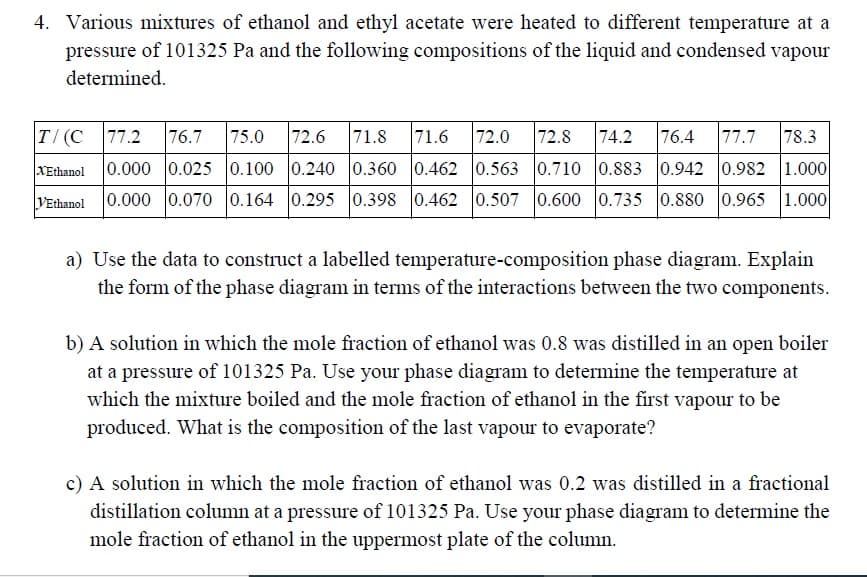4. Various mixtures of ethanol and ethyl acetate were heated to different temperature at a pressure of 101325 Pa and the following compositions of the liquid and condensed vapour determined. T/(C 77.2 76.7 75.0 72.6 71.8 71.6 72.0 72.8 74.2 76.4 77.7 78.3 XEthanol 0.000 0.025 0.100 0.240 0.360 0.462 0.563 0.710 0.883 0.942 0.982 1.000 VEthanol 0.000 0.070 0.164 0.295 0.398 0.462 0.507 0.600 0.735 0.880 0.965 1.000 a) Use the data to construct a labelled temperature-composition phase diagram. Explain the form of the phase diagram in terms of the interactions between the two components.
4. Various mixtures of ethanol and ethyl acetate were heated to different temperature at a pressure of 101325 Pa and the following compositions of the liquid and condensed vapour determined. T/(C 77.2 76.7 75.0 72.6 71.8 71.6 72.0 72.8 74.2 76.4 77.7 78.3 XEthanol 0.000 0.025 0.100 0.240 0.360 0.462 0.563 0.710 0.883 0.942 0.982 1.000 VEthanol 0.000 0.070 0.164 0.295 0.398 0.462 0.507 0.600 0.735 0.880 0.965 1.000 a) Use the data to construct a labelled temperature-composition phase diagram. Explain the form of the phase diagram in terms of the interactions between the two components.
Chemistry
10th Edition
ISBN:9781305957404
Author:Steven S. Zumdahl, Susan A. Zumdahl, Donald J. DeCoste
Publisher:Steven S. Zumdahl, Susan A. Zumdahl, Donald J. DeCoste
Chapter1: Chemical Foundations
Section: Chapter Questions
Problem 1RQ: Define and explain the differences between the following terms. a. law and theory b. theory and...
Related questions
Question
#4. thank you.

Transcribed Image Text:4. Various mixtures of ethanol and ethyl acetate were heated to different temperature at a
pressure of 101325 Pa and the following compositions of the liquid and condensed vapour
determined.
T/(C 77.2
76.7
75.0
72.6
71.8
71.6
72.0
72.8
74.2
76.4
77.7
78.3
0.000 0.025 0.100 0.240 0.360 0.462 0.563 0.710 0.883 0.942 0.982 1.000
XEthanol
YEthanol
0.000 0.070 0.164 0.295 0.398 0.462 0.507 0.600 0.735 0.880 0.965 1.000
a) Use the data to construct a labelled temperature-composition phase diagram. Explain
the form of the phase diagram in terms of the interactions between the two components.
b) A solution in which the mole fraction of ethanol was 0.8 was distilled in an open boiler
at a pressure of 101325 Pa. Use your phase diagram to determine the temperature at
which the mixture boiled and the mole fraction of ethanol in the first vapour to be
produced. What is the composition of the last vapour to evaporate?
c) A solution in which the mole fraction of ethanol was 0.2 was distilled in a fractional
distillation column at a pressure of 101325 Pa. Use your phase diagram to determine the
mole fraction of ethanol in the uppermost plate of the column.
Expert Solution
This question has been solved!
Explore an expertly crafted, step-by-step solution for a thorough understanding of key concepts.
Step by step
Solved in 3 steps with 1 images

Knowledge Booster
Learn more about
Need a deep-dive on the concept behind this application? Look no further. Learn more about this topic, chemistry and related others by exploring similar questions and additional content below.Recommended textbooks for you

Chemistry
Chemistry
ISBN:
9781305957404
Author:
Steven S. Zumdahl, Susan A. Zumdahl, Donald J. DeCoste
Publisher:
Cengage Learning

Chemistry
Chemistry
ISBN:
9781259911156
Author:
Raymond Chang Dr., Jason Overby Professor
Publisher:
McGraw-Hill Education

Principles of Instrumental Analysis
Chemistry
ISBN:
9781305577213
Author:
Douglas A. Skoog, F. James Holler, Stanley R. Crouch
Publisher:
Cengage Learning

Chemistry
Chemistry
ISBN:
9781305957404
Author:
Steven S. Zumdahl, Susan A. Zumdahl, Donald J. DeCoste
Publisher:
Cengage Learning

Chemistry
Chemistry
ISBN:
9781259911156
Author:
Raymond Chang Dr., Jason Overby Professor
Publisher:
McGraw-Hill Education

Principles of Instrumental Analysis
Chemistry
ISBN:
9781305577213
Author:
Douglas A. Skoog, F. James Holler, Stanley R. Crouch
Publisher:
Cengage Learning

Organic Chemistry
Chemistry
ISBN:
9780078021558
Author:
Janice Gorzynski Smith Dr.
Publisher:
McGraw-Hill Education

Chemistry: Principles and Reactions
Chemistry
ISBN:
9781305079373
Author:
William L. Masterton, Cecile N. Hurley
Publisher:
Cengage Learning

Elementary Principles of Chemical Processes, Bind…
Chemistry
ISBN:
9781118431221
Author:
Richard M. Felder, Ronald W. Rousseau, Lisa G. Bullard
Publisher:
WILEY